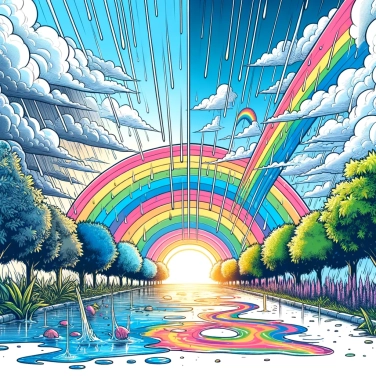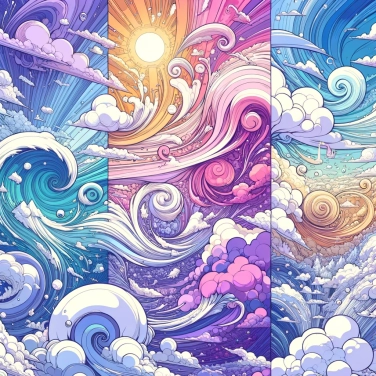Rainbows appear after the rain because sunlight is refracted and reflected by water droplets suspended in the air, creating a colorful spectrum.

When the white light from the sun passes through a raindrop, it changes direction: this is refraction. As the light enters the drop, it separates into different colors because each one refracts a little differently. Just after, it bounces off the inside of the drop, that’s internal reflection, before coming out again towards us, scattered in a spectrum of colors. Essentially, each droplet acts like a tiny natural prism, transforming a white ray into a beautiful gradient of colors ranging from red to violet.
Just after a good downpour, thousands of water droplets remain suspended in the air. Each acts like a mini prism: it captures sunlight, reflects it internally while separating it into all its colors, and then sends this colored light back to your eyes. To clearly observe a rainbow, the sun must be at your back and the raindrops in front of you. The sunlight then meets the droplets at the right angle to create this spectacle. Without these fine droplets left after the rain, it is impossible for the rainbow to form.
You can't see a rainbow from just any angle. Your positioning matters as much as the light itself. Generally, a rainbow appears precisely if you observe it at about 42 degrees relative to the rays of the sun coming from behind you. It's not a magical number, just a matter of optics: light enters the water droplets, bends inside them, and then exits back toward your eyes at that specific angle. If you move a little, the rainbow moves with you, because it’s an optical illusion related to your perspective. That's why two people in different locations never see exactly the same rainbow.
The ideal conditions for seeing rainbows depend mainly on a few essential parameters. First, a quick shower or stormy weather followed by sudden clearings is needed: suspended raindrops and a sunbeam that is intense enough but low in the sky. The perfect moment often occurs during the beginning or end of the day, because the sun is lower on the horizon and shines at a good angle. Additionally, a clear sky in the direction opposite to the sun allows for a distinct contrast that beautifully highlights the colors. A fairly clear atmosphere without thick clouds directly covering the sun will also help to enjoy a well-visible and vibrant rainbow. Finally, regions with brief showers alternating between sun and frequent rain—typically in spring or autumn—are the champions of easily observable rainbows.
The size of water droplets affects the visibility and intensity of the colors in a rainbow: larger droplets will enhance the brightness and sharpness of the observed colors.
Secondary arcs, known as supernumerary arcs, can sometimes be observed just inside the main arc as small alternating pale bands due to light diffraction.
Each observer sees their own rainbow: two people never see exactly the same one, as each perceives it from a different angle depending on their position.
The complete rainbow actually forms a circle, but the ground usually prevents us from seeing the lower part, unless we are at a higher altitude, for example, in an airplane or on a mountain.
Rainbows appear curved due to the optical phenomenon produced by water droplets. Each droplet refracts and reflects light at a specific angle; when these angles are combined, the observer perceives a circular arc from their viewpoint.
This second arc, called the secondary arc, appears when light rays undergo two reflections inside water droplets. It is often fainter, and its colors appear in the reverse order compared to the primary rainbow.
Yes! They are called 'moonbows'. They appear more rarely when the light reflected by the Moon passes through a very fine curtain of rain. They appear white or pale because moonlight is weaker than sunlight, limiting our ability to distinguish colors.
The order of colors in a rainbow is constant (red, orange, yellow, green, blue, indigo, and violet). However, the sharpness and intensity of the colors can vary significantly depending on the size of the water droplets, the light intensity, fog, or even atmospheric pollution.
Unfortunately, no! A rainbow is a visual illusion created by the refraction, reflection, and dispersion of light. It is not made up of a physical object that one can approach or touch.

No one has answered this quiz yet, be the first!' :-)
Question 1/5